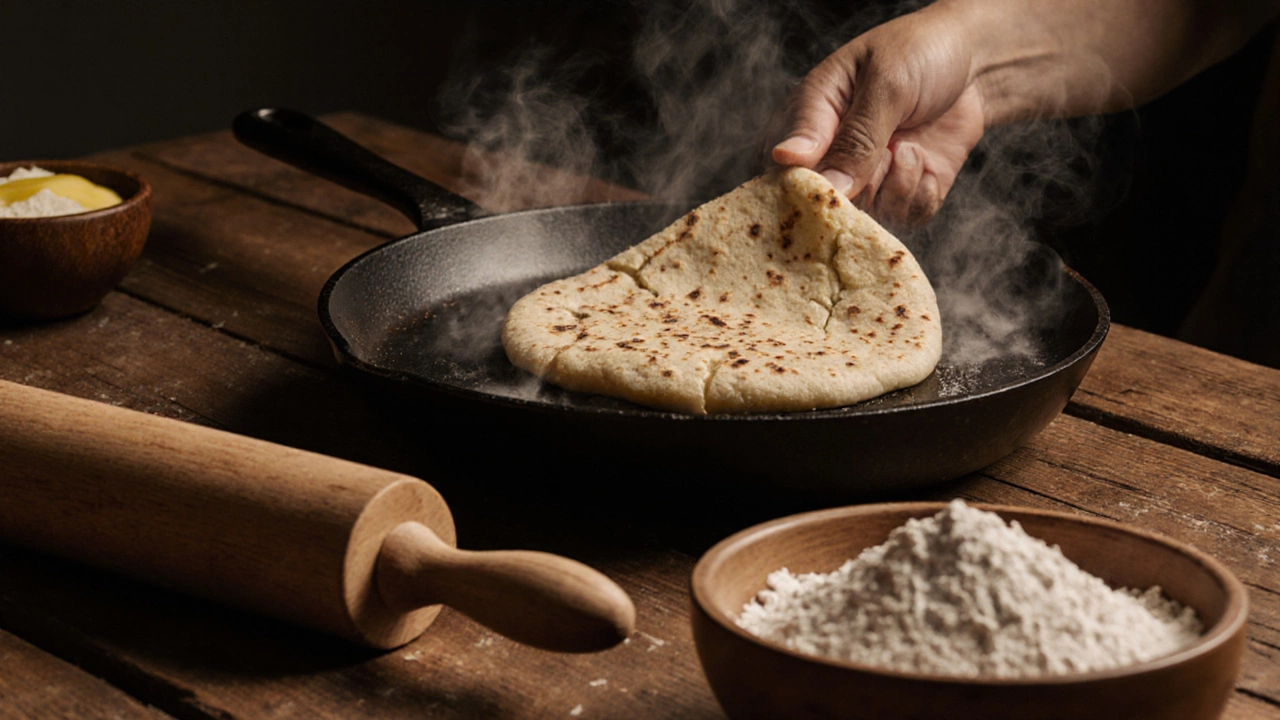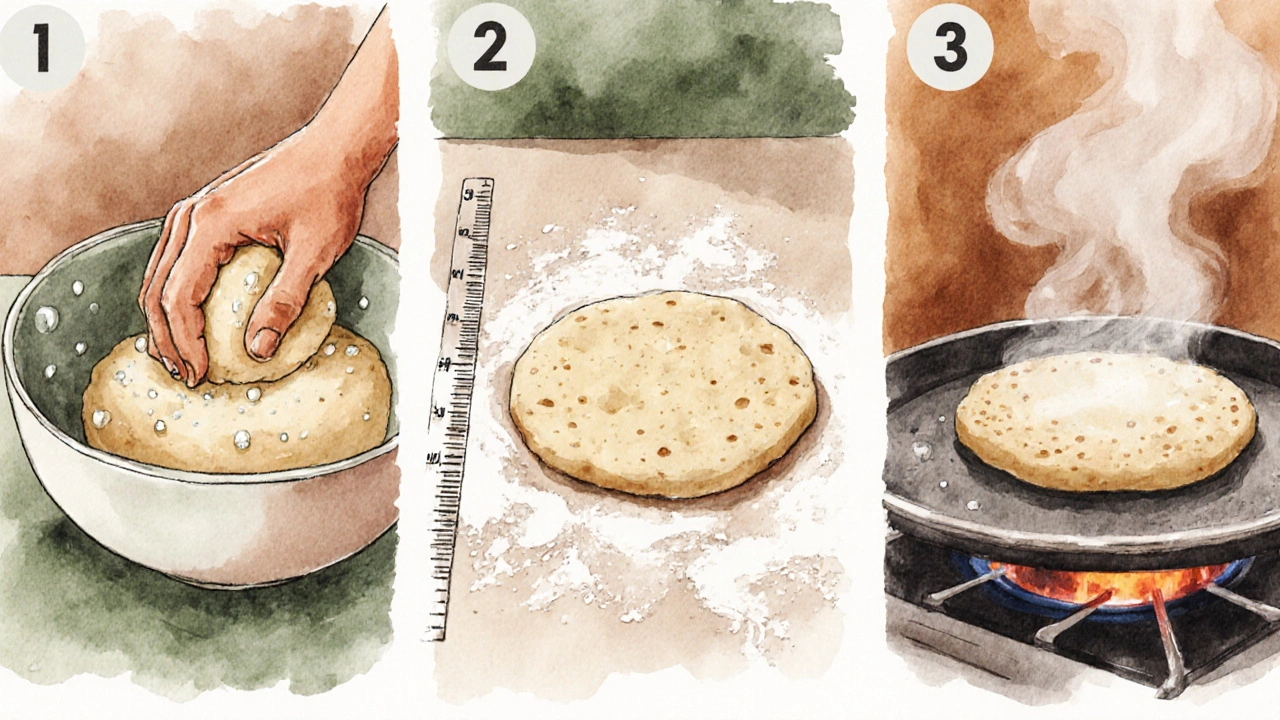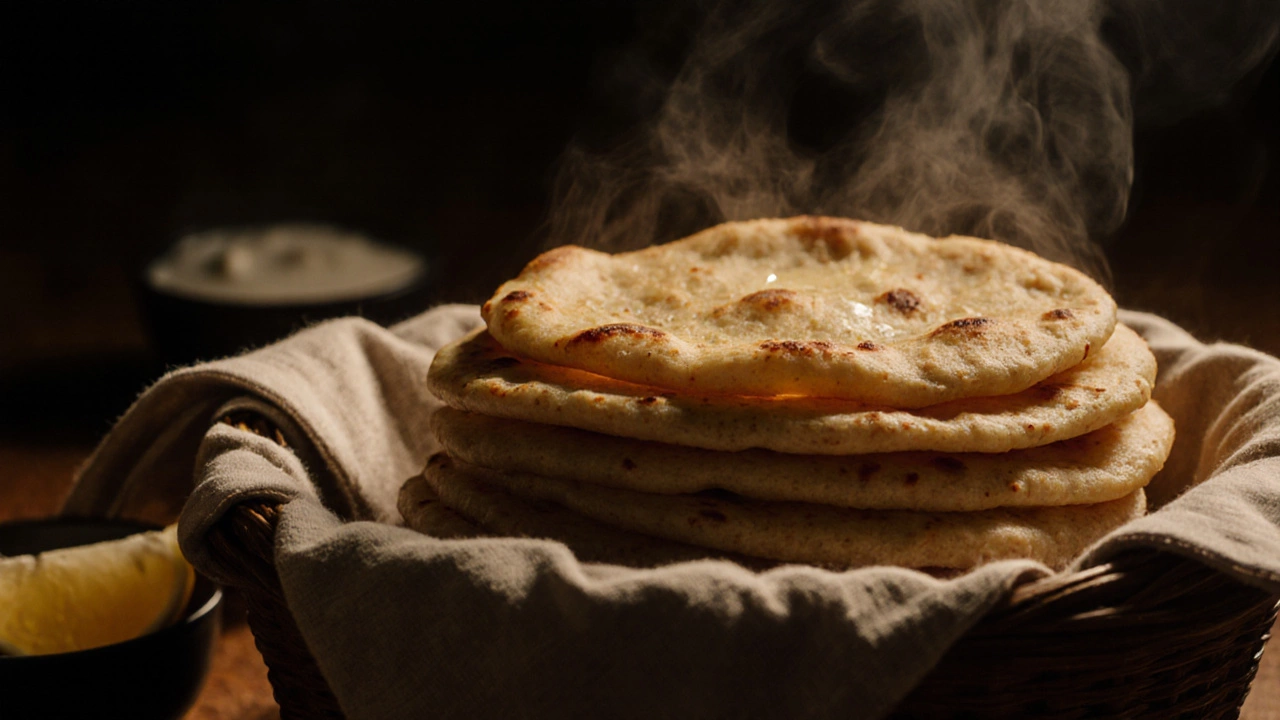How to Make Soft Rotis: Top Tips for Tender Indian Flatbreads
 Oct, 23 2025
Oct, 23 2025
Roti Troubleshooting Guide
Encountering problems with your rotis?
Select the issue you're experiencing to get a targeted solution. This guide helps you diagnose and fix common roti texture problems for perfectly soft, fluffy flatbreads every time.
Hard & Dry Roti
Roti feels tough, dry, and crumbly
Cracking During Rolling
Dough cracks when rolling into circles
No Puff, Stays Flat
Roti doesn't puff up on the tawa
Sticking to Tawa
Roti sticks to the cooking surface
Ever pulled a roti off the Roti a thin Indian flatbread traditionally cooked on a hot griddle and found it hard as a board? It’s a common frustration, especially when you’ve followed a recipe to the letter. The good news is that a few tweaks in ingredients, technique, and timing can turn a tough round into a fluffy, soft delight every time.
What Makes a Roti Soft?
A soft roti starts with the right balance of Whole Wheat Flour a coarse yet nutritious flour that forms the backbone of the dough, water, and a touch of fat. The dough should be pliable, not sticky, and it needs enough time to relax so gluten strands can unwind. When you cook it on a sufficiently hot Tawa a flat Indian griddle that distributes heat evenly, the surface puffs and creates those airy pockets we love.
Common Reasons Your Rotis End Up Hard
- Using too little water - the dough becomes dry and cracks during rolling.
- Over‑kneading - excessive gluten development makes the roti tough.
- Skipping the resting period - the dough doesn’t relax, leading to shrinkage.
- Cooking on low heat - the roti dries out before it can puff.
- Applying too much flour while rolling - adds unnecessary dryness.
- Neglecting a fat source - no moisture seal, so the roti hardens quickly.
Step‑by‑Step Guide to Consistently Soft Rotis
- Measure Water room‑temperature water to hydrate the flour - start with 1 cup water for every 2 cups flour and adjust as needed.
- Add a pinch of salt and, if you like, 1‑2 teaspoons of Ghee clarified butter that adds softness and flavor to the mixture.
- Mix until a shaggy dough forms, then knead gently for 4‑5 minutes. The dough should be smooth but not sticky.
- Cover the bowl with a damp cloth and let it rest for 20‑30 minutes. This rest is crucial for gluten relaxation.
- Divide the dough into golf‑ball‑size portions. Lightly dust each with flour and roll using a Rolling Pin a cylindrical tool that flattens dough evenly to a 6‑inch circle.
- Heat the Tawa on medium‑high until a few drops of water sizzle immediately. This is the ideal Cooking Temperature approximately 200‑220°C for quick puffing. \n
- Place the roti on the tawa. Cook for 30‑40 seconds until white spots appear, then flip.
- After the second flip, press gently with a clean cloth or a spatula; the roti should puff up. Cook another 10‑15 seconds, then remove.
- Immediately brush with a thin layer of ghee or keep in a covered basket to trap steam.

Ingredient Tweaks That Make a Big Difference
While the basic recipe works for most, small adjustments can elevate the texture.
- Hydration level: Aim for a dough that feels slightly tacky. Higher water content (around 60‑65% of flour weight) yields a softer crumb.
- Fat addition: Besides ghee, a spoonful of yogurt or milk can introduce extra moisture, making the roti more supple.
- Salt: A pinch improves gluten structure and flavor, but too much can tighten the dough.
- Whole Wheat Flour quality: Freshly milled flour retains more natural oils, which helps softness.
Technique Adjustments for Perfect Puff
The art of puffing a roti lies in timing and heat control.
- Rest the dough - as noted, Resting Time the period that allows gluten fibers to relax prevents shrinkage.
- Even rolling - avoid thinning the center too much. A uniform thickness cooks evenly and puffs better.
- Hot tawa - a hot surface causes steam to form rapidly, lifting the roti. If the tawa is cool, the roti dries out.
- Pressure flip - when the roti starts to bubble, give it a quick press with a cloth. This encourages the air pockets to expand.

Quick Troubleshooting Table
| Problem | Likely Cause | Simple Fix |
|---|---|---|
| Hard, dry roti | Low hydration or too much flour on rolling | Increase water by 10‑15 ml; dust lightly instead of sprinkling heavily |
| Roti cracks while rolling | Insufficient resting time | Rest dough for at least 20 minutes; cover with a damp cloth |
| No puff, stays flat | Cooking temperature too low | Preheat tawa until water droplets sizzle instantly; medium‑high heat |
| Roti sticks to the tawa | Surface not hot enough or too much flour on roti | Ensure tawa is hot; wipe excess flour before placing roti |
Pro Tips and Variations
- For a slightly richer bite, mix 10 % maida (all‑purpose flour) with whole wheat. It still feels wholesome but softens the texture.
- Add a teaspoon of lemon juice to the dough; the acidity relaxes gluten further.
- Store cooked rotis in a cotton cloth-lined container. The trapped steam keeps them soft for hours.
- Try a quick 5‑minute steam‑blanch of the dough before rolling - dip the ball in hot water for a second, then roll. It creates extra moisture inside.
FAQ
Why does my roti get hard after cooling?
As the roti cools, steam escapes and the gluten tightens. Keeping them in a covered cloth or container traps moisture, preserving that soft roti feel.
Can I use a non‑stick pan instead of a tawa?
Yes, but a traditional cast‑iron tawa distributes heat more evenly, helping the roti puff properly. If you use a non‑stick pan, make sure it’s pre‑heated well.
Is it okay to add baking powder?
A pinch (¼ tsp per cup of flour) can give a slight lift, but too much makes the roti cakey. For classic softness, rely on steam and dough hydration.
How long can I store homemade rotis?
Refrigerated, they stay good for 2‑3 days if wrapped tightly. Reheat on a hot tawa for a few seconds to restore softness.
What’s the best flour brand for soft rotis?
Look for fresh, stone‑ground whole wheat flour with a slightly higher protein content (around 12‑13%). It holds moisture better, giving you a softer bite.
With the right balance of water, a brief rest, and a hot tawa, you’ll say goodbye to tough, chewy rotis and hello to fluffy, soft rounds that pair perfectly with any curry or dal. Keep these tips handy, experiment a little, and soon you’ll be the go‑to roti maker in your kitchen.
